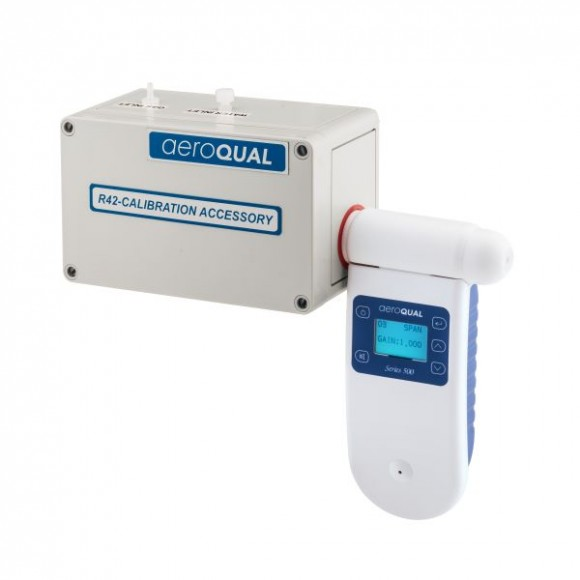Aeroqual Calibration Information

Aeroqual Portable Monitors Calibrations FAQ
This technical information on this page is relevant for the Handheld Series-200, 300, 500, and Fixed Mount Series-900, 930, 940. For information on the SM-70 and SM-50 scroll to the bottom of this page.
1. What do I calibrate - the monitor or the sensor head?
Aeroqual’s unique system of interchangeable sensor heads means they can be calibrated independently of the monitor. If you are sending a sensor head to us for factory calibration, then you do not need to send the monitor back. The monitor base does not need to be calibrated. Note: the Series 300 and 500 monitor bases can be used to calibrate the zero and span of any sensor head (including those from one of our fixed monitors); the Series 200 base can only be used for a zero calibration.
2. How do I know my sensor head is reading accurately?
All our sensor heads come with a factory calibration certificate. Over time the sensor head will need to be re-calibrated to ensure it is reading accurately. See below for a full discussion of how and when to re-calibrate. In between calibrations, particularly when the monitor is being used for health and safety purposes, a bump test is used to check the sensor is responding.
3. How do I do a bump test?
A bump test typically involves brief exposure of the sensor to a known quantity of gas and making sure the monitor reading corresponds with that concentration. Unlike calibration there is no adjustment of the monitor in response to the level of gas detected. For instructions on how to bump test your handheld monitor, please consult the User Guide.
4. What is the difference between a zero and span calibration?
A bump test typically involves brief exposure of the sensor to a known quantity of gas and making sure the monitor reading corresponds with that concentration. Unlike calibration there is no adjustment of the monitor in response to the level of gas detected. For instructions on how to bump test your handheld monitor, please consult theUser Guide.
5. What is the difference between field and factory calibration?
As the name suggests factory calibration means calibration by the manufacturer or suitably qualified laboratory. Field calibration involves calibration of the sensor head by the end user.
6. How do I calibrate my ozone sensor head in the field?
There is an important difference between ozone and other types of gases. Ozone cannot be stored in bottles. Instead ozone must be generated at source using an ozone generator. A zero calibration can be done using a zero air bottle, but for a span calibration you must be able to generate ozone. If you have an ozone generator/calibrator then instructions on field calibration can be found in the User Guide.. If you do not have an ozone generator/calibrator then we recommend sending the ozone sensors for factory calibration (see below). Note: this applies for our Perc sensor heads too, because Perc is only available as a solvent.
7. How do I calibrate my non ozone sensor head in the field?
For non-ozone sensors, instructions on field calibration using calibration gas can be found in theUser Guide..You can watch a video demonstration of a single sensor head calibration here:
8. How often do I need to field calibrate my sensor head?
This depends on the level of rigour required in your measurement application. Researchers may calibrate before every measurement they take. But for most people regular calibration is enough to ensure good results. By regular we mean once or twice per year. For the reasons of cost and complexity outlined above, customers tend to calibrate ozone sensor heads less often and instead send them to the manufacturer or laboratory once every year or so.
9. How do I factory calibrate my sensor head?
Simply send the sensor head to us or a suitably qualified laboratory. Our charges for factory calibration are quite reasonable. Please contact us for a quotation.
10. How often do I need to factory calibrate my sensor head?
If you’re able to field calibrate your sensor head you may never need to send it to us for calibration. However if you want to be 100% sure of the calibration, an annual factory calibration complete with certificate provides ultimate peace of mind. Ozone sensors are hard to calibrate in the field so we recommend sending for factory calibration once every year.
11. What is the expected lifetime of the sensor head?
This is hard to answer as it depends on the type of sensor and the application it used in. As a guide assume your sensor will last two years, however higher exposure levels or harsh environments can lead to a significant reduction in life expectancy. Your monitor display is likely to indicate “Sensor Failure” or “Sensor Ageing” if the sensor is nearing the end of its useful life.
12. How do I read Aeroqual's sensor calibration certificate?
Every sensor head we send out comes with a calibration certificate. Click here to see a visual explanation of the contents of your calibration certificate.
SM-70 and SM-50 Calibration Information
The SM-70 and SM-50 zero calibration can be checked, and adjusted as necessary with a zero calibration switch installed on the sensor board. The span calibration can also be checked or verfied following a procedure in the User Manual. However, there is no field calibration option for these sensors. The only calibration method is to ship back to the factory.
The SM-50 sensor board is a lows cost sensor that is not cost effective to ship back and forth for calibration. It is intended that this sensor is replaced annually with a new sensor to keep the calibration up to date.
The SM-70 uses the SM-50 sensor board inside. It is expected that the SM-50 is replaced annually in the SM-70 to keep the calibration current.





